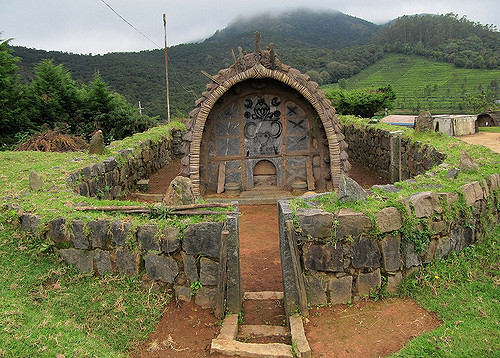
Toda Temple at the Nilgiris
Traditional Ecological Knowledge (TEK)
As defined by the Convention on Biological Diversity, Article 8 (j):
Traditional knowledge refers to the knowledge, innovations and practices of indigenous and local communities around the world. Developed from experience gained over the centuries and adapted to the local culture and environment, traditional knowledge is transmitted orally from generation to generation. It tends to be collectively owned and takes the form of stories, songs, folklore, proverbs, cultural values, beliefs, rituals, community laws, local language, and agricultural practices, including the development of plant species and animal breeds. Traditional knowledge is mainly of a practical nature, particularly in such fields as agriculture, fisheries, health, horticulture, and forestry.
Traditional Ecological Knowledge (TEK) can also be viewed as a system of self-management, an extremely valuable source of environmental information that allows indigenous or other isolated native communities to protect and preserve their way of life. It is the basis for local decision-making in agriculture, hunting and gathering, nutrition and food preparation, resource management, education and health as well as social, economic, and political organization. This is now recognized as “the inextricable link between cultural and biological diversity” (1988 Declaration of Belém).
The use of TEK has found favour in conservation planning and resource assessment for three reasons: efficiency, additionality, and community engagement. With biodiversity concerns having been pushed upfront, in more recent times, in the context of global change, traditional ecological knowledge encompassing all issues linked to ecology and natural resources management has assumed greater significance. When knowledge about the consequences of management is scarce, these alternative management methods can be of great value and help.
The following list is adapted from the IUCN Programme on Traditional Knowledge for Conservation (IUCN 1986):
- Traditional knowledge for new biological and ecological insights: New scientific knowledge can be derived from perceptive investigations of traditional environmental knowledge systems, as in the case of life cycles of tropical reef fish.
- Traditional knowledge for resource management: Much traditional knowledge is relevant for contemporary natural resource management, in such areas as wetlands. “Rules of thumb” developed by ancient resource managers and enforced by social and cultural means, are in many ways as good as Western scientific prescriptions.
- Traditional knowledge for protected areas and for conservation education: Protected areas may be set up so as to allow resident communities to continue their traditional lifestyles, with the benefits of conservation accruing to them. Especially where the local community jointly manages such a protected area, the use of traditional knowledge for conservation education is likely to be very effective.
- Traditional knowledge for development planning: The use of traditional knowledge may benefit development agencies in providing more realistic evaluations of environment, natural resources and production systems. Involvement of the local people in the planning process improves the chance of success of development.
- Traditional knowledge for environmental assessment: People who are dependent on local resources for their livelihood are often able to assess the true costs and benefits of development better than any evaluator coming from the outside. Their time-tested, in-depth knowledge of the local area is, in any case, an essential part of any impact assessment.
Natural Resource Management has been in the traditions of the Indian society, expressing itself variously in the management and utilization practices. Ancient religious texts like Vedas, Ramayana, Mahabharata and non religious texts like Kautilya’s Artha-sastra, Krishi-Parashara, Kashyapiyakrishisukti, Vrikshayurveda, Krishi Gita deal with various aspects of management of natural resources.
In India the necessity of natural resources for the survival of Indigenous tribes had made them to evolve a system having some customary laws and practices, which helped them to conserve the surrounding natural resources. The various religious philosophies of these tribes have contributed significantly in the conservation of forests, biodiversity and landscapes by promulgating customary norms, practices and beliefs.
An assessment of TEK in India shows that it encompasses several fields, namely, sustainable forest management, biodiversity conservation by sacred groves, sacred landscape and sacred plant species, crop management, farm management, animal management and therapeutic role of Ayurveda.
However, with the advent of commercial interests in the forests and biodiversity, the indigenous philosophy and practices including religious approach adopted by the local communities for conservation of biodiversity were overlooked resulting in several irregularities and concerns in the conservation and management of natural resources.
For centuries, indigenous communities were used to surviving and adjusting their agriculture, fishing and hunting in the event of changes in climate. It is ironical that now when the threat of climate change is so imminent we are looking for solutions outside. However, there is another threat looming large, that is, of losing these communities to outright annihilation or due to their amalgamation in the mainstream. Moreover, with the commercialization of natural resources, traditional knowledge that managed to maintain sustainable levels of harvest has been sidelined. The existing policy and legal mechanisms to protect traditional knowledge usually does not involve these communities themselves. Hence they do little to safeguard local community needs, values and customary laws relating to traditional knowledge and genetic resources of indigenous and local communities. We have to preserve this aspect of culture and amalgamate it with modern methods to work towards environmental conservation.
Source
http://www.ecologyandsociety.org/vol15/iss1/art3/
http://www.ichstm2013.com/programme/guide/p/0264.html
http://www.infinityfoundation.com/mandala/t_es/t_es_pande_conserve.htm


